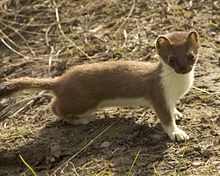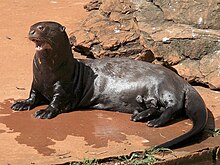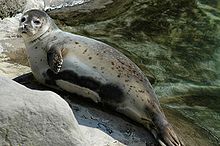Marten relatives
| Marten relatives | ||||||||||||
|---|---|---|---|---|---|---|---|---|---|---|---|---|

Pine marten ( Martes martes ) |
||||||||||||
| Systematics | ||||||||||||
|
||||||||||||
| Scientific name | ||||||||||||
| Musteloidea | ||||||||||||
| Fischer , 1817 |
The marten relatives (Musteloidea) are a group of predominantly small to medium - sized canine - like predators that occur today with four families on all continents with the exception of Antarctica . The giant panda was formerly included in this group; but today he is seen as a representative of the bears . Many of them were and are important to humans as fur animals and were hunted accordingly.
description
Marten-like are predominantly small to medium-sized predators that have mainly adapted to a hidden way of life. With a total length of up to two meters, the giant otter is the largest relative of the marten, the weasel with a head body length of 11 to 26 centimeters is the smallest predator of all. Both species belong to the marten family . The marten relatives are quite different in their physique. They usually have a rather slim, low-build body with not too long legs (especially most martens and the little panda), but there are also more stocky groups represented. Some species only give the appearance of a strong body through their thick fur. Among the raccoon relatives include Halbsohlen- and plantigrade , with the length of the feet not far exceeds the actual leg bones. Many move around with their cats hunched over. The paws are equipped with well-developed claws, which are only partially retractable in a few species. The specialization in different ways of life naturally also brings with it anatomical changes, for example the streamlined body with flattened tail and webbed feet in otters or the extremely slim body shape of the mouse weasel. Most have long, well-haired tails . The wrapped bear , who specializes in climbing trees, has a prehensile tail. The head is usually relatively short, the face turned forward.
The martens are predominantly slender, short-legged animals compared to the body with a rather short neck and short to medium-long tail, although there are also stronger types of badgers , silver badgers , honey badgers and wolverines . The small bears combine characteristics of martens and real bears in their rather stocky body, for example being walkers . Skunks resemble small, stocky martens with bushy tails. The lesser panda is similar to the small bear, but has a slim body and a short, wide face.
The dentition is typical of predators, incisors , canines ( transformed into fangs ), front teeth and molars are present. Depending on the diet, the molars can be more or less widened. The number of teeth varies from species to species between 28 and 40 (28 to 38 in martens and 36 to 40 in small bears).
Some species are able to squirt a stinking defense secretion from their paired anal glands one and a half to two meters away. This ability is not limited to the Skunks family , some martens can also defend themselves in this way.
Distribution, habitat and biology
Marten relatives are predominantly smaller, hidden animals. Most are crepuscular and nocturnal and hide in a shelter during the day. Various smaller animals and plants serve as food. Many feed on rodents and birds . Otters mainly feed on fish and other aquatic animals, while the little panda mainly eats bamboo and other plants. As opportunistic omnivores, skunks and many small bears have a very diverse diet, wolverines eat berries and shoots, as well as carrion and even killed elk calves . In contrast, the mouse weasel , for example, is a specialist that feeds almost exclusively on small rodents. The honey badger shows a certain preference for honey , but is otherwise not picky.
Marten relatives are common across all continents except for Antarctica . In Australia, Oceania, New Zealand and Madagascar, however, they were introduced by humans. They prefer forest-like habitats with hiding places in which they can hang out during the day, but they also occur in a wide variety of other habitats. These shelters can be natural structures, but they can also be built by them, other animals or humans.
Systematics






Within the canine species , the marten relatives, together with the seals , their sister group , and the bears form a rank-less taxon called Arctoidea . They themselves consist of four families, of which the Skunks (Mephitidae) are the sister group of the other families. This system shows the following cladogram:
| Caniformia |
|
||||||||||||||||||||||||||||||||||||
|
|
The largest family of the marten-like is that of the marten with 20 genera and 58 species , making them the largest family of predators . The small bears consist of only six genera and 15 species. The 12 types of Skunks are distributed over four genera. The smallest family, the little pandas, includes only two species.
In older systematics, families are often amalgamated in different ways. The Skunks were counted among the martens, the small pandas together with the giant panda in their own family or among the small bears. Finally, the skunks were separated from the martens, the small bears from the pandas, and the giant panda was classified in the bear family , so that the system discussed here resulted.
- Marten relatives (Musteloidea)
- Family Ailuridae
- Genus Little Pandas ( Ailurus )
- Skunks family (Memphitidae)
- Genus Weißrüsselskunks ( Conepatus )
- Genus Streifenskunks ( Memphitis )
- Genus stink badger ( Mydaus )
- Genus Fleckenskunks ( Spilogale )
- Small bear family (Procynonidae)
- Marten family (Mustelidae)
- Subfamily Ictonychinae
- Genus Grisons ( Galictis )
- Genus Ictonyx
- White- naped weasel ( Poecilogale albinucha )
- Tigeriltis ( Vormela peregusna )
- Subfamily Helictidinae
- Genus sun badger ( Melogale )
- Subfamily Martinae
- Tayra ( Eira )
- Wolverine ( gulo )
- Genus Real Marten ( Martes )
- Subfamily badgers (Melinae)
- Honey badger subfamily (Mellivorinae)
- Honey badger ( mallivora capensis )
- Subfamily Mustelinae
- Patagonian weasel ( Lyncodon patagonicus )
- Genus Mustela
- Genus Neovison
- Subfamily Otter (Lutrinae)
- Genus finger viper ( Aonyx )
- Sea otter ( Enhydra lutris )
- Spot-necked otter ( Hydrictis maculicollis )
- Genus New World Otter ( Lontra )
- Genus Old World Otter ( Lutra )
- Indian otter ( Lutrogale perspicillata )
- Giant otter ( Pteronura brasiliensis )
- Subfamily silver badgers (Taxidiinae)
- Badger ( Taxidae taxus )
- Subfamily Ictonychinae
- Family Ailuridae
Development history

The marten relatives seem to be a very old group of predators. Its origin is to be sought in the paleogene. The martens are particularly primal, which can be recognized by their anatomical features. Martens have been recorded since the Paleogene . Some sources lead them back to the Paleocene , others to the transition period between the Upper Eocene and the Lower Oligocene . The original martens still had strong similarities to small bears that have been known since the Oligocene. Both families originated in the ancient world, but could be found in America as early as the Oligocene. Small bears have been recorded there since the Lower Oligocene, but finds of predators with a small bear-like hearing region from Eurasia suggest that the small bears originated in the ancient world. The small bears died out there, possibly due to competition from the stealthy cats . If there were martens and small bears at the top of the cladogram of marten relatives by this time, this suggests that skunks and pandas split off from them earlier.
Already in the Upper Oligocene, the martens produced otter-like forms that were better adapted to aquatic life than they are today, such as Polamotherium . However , these animals are not to be regarded as ancestors of seals . Marten and weasel-like forms are also known from this period. In the Neogene a radiation began in connection with the cooling of the world climate, in which many of today's taxa originated. Since then, skunks with genera such as Miomemphitis and Trochotherium have also been found in Eurasia, and badger-like ones with trocharion . In addition, at that time there were already Katzenfrette who survived to this day. Skunks have been found in North America since the Pliocene ; in Europe there were precursors of today's species, such as the wolverine ( Plesiogulo ), the Grisons ( Pannonictis ) and the weasel and polecat ( Baranogale ). Parailurus , a relative of today's little panda, lived in Europe at that time . Honey badgers and sea otters have only existed since the Ice Age. A remarkable species of otter from Kazakhstan, Semantor macrurus , was apparently even better adapted to life in the water than today's sea otter.
swell
literature
- Bernhard Grzimek : “ Grzimek's animal life . The modern encyclopedia of the entire animal kingdom. ”1970 Kindler Verlag AG, Zurich
- Theo Jahn: “Brehm's New Animal Cyclopedia.” 1981 Herder KG publishing house, Freiburg im Breisgau
Individual evidence
- ↑ a b c d e f g Theo Jahn: "Brehms Neue Tierzyklopädie." 1981 Verlag Herder KG, Freiburg im Breisgau
- ↑ a b c d e f Bernhard Grzimek : “ Grzimeks animal life . The modern encyclopedia of the entire animal kingdom. ”1970 Kindler Verlag AG, Zurich
- ↑ a b "Brockhaus - The Encyclopedia: in 24 volumes." - 20th, revised. and updated edition. 1998 FA Brockhaus GmbH, Mannheim
- ↑ Chris J. Law, Graham J. Slater, Rita S. Mehta: Lineage Diversity and Size Disparity in Musteloidea: Testing Patterns of Adaptive Radiation Using Molecular and Fossil-Based Methods. Systematic Biology, Volume 67, Issue 1, January 2018, Pages 127–144, doi: 10.1093 / sysbio / syx047
Web links
- Family tree of mammals (PDF; 906 kB)
